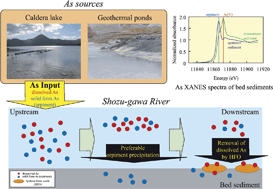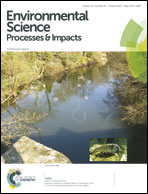The fate of arsenic in a river acidified by volcanic activity and an acid thermal water and sedimentation mechanism†
Abstract
The Shozu-gawa river, located in the Aomori Prefecture, northern Japan, is affected by volcanic activities and acid thermal waters. The river is unique because both solid arsenic (As; as orpiment, As2S3) and dissolved As are supplied to the river from the uppermost caldera lake (Usori-ko Lake) and thermal ponds. The watershed is an excellent site for investigating the fate of different As species in a fluvial system. Upstream sediments near the caldera lake and geothermal ponds are highly contaminated by orpiment. This solid phase is transported as far as the mouth of the river. On the other hand, dissolved As is removed from the river system by hydrous ferric oxides (HFOs); however, HFO formation and removal of dissolved As do not occur in the uppermost area of the watershed, resulting in further downstream transport of dissolved As. Consequently, upstream river sediments are enriched in orpiment, whereas As(V), which is associated with HFOs in river sediments, increases downstream. Furthermore, orpiment particles are larger, and possibly heavier, than those of HFO with sorbed As. Fractionation between different chemical states of As during transport in the Shozu-gawa river is facilitated not only by chemical processes (i.e., sorption of dissolved As by HFOs), but also by physical factors (i.e., gravity). In contrast to acid mine drainage (AMD), in some areas of the Shozu-gawa river, both solid forms of As (as sulfide minerals) and dissolved As are introduced into the aquatic system. Considering that the stabilities of sulfide minerals are rather different from those of oxides and hydroxides, river sediments contacted with thermal waters possibly act as sources of As under both aerobic and anaerobic conditions.


 Please wait while we load your content...
Please wait while we load your content...